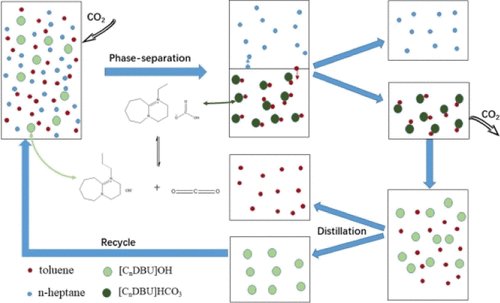Our official English website, www.x-mol.net, welcomes your feedback! (Note: you will need to create a separate account there.)
Preparation and Application of CO2-Triggered Switchable Solvents in Separation of Toluene/n-Heptane.
Langmuir ( IF 3.9 ) Pub Date : 2020-01-06 , DOI: 10.1021/acs.langmuir.9b02890 Zidong Zhang 1 , Yuming Tu 1 , Hui Yu 1 , Weidong Liu 1 , Zhiyong Zhou 1 , Zhongqi Ren 1
Langmuir ( IF 3.9 ) Pub Date : 2020-01-06 , DOI: 10.1021/acs.langmuir.9b02890 Zidong Zhang 1 , Yuming Tu 1 , Hui Yu 1 , Weidong Liu 1 , Zhiyong Zhou 1 , Zhongqi Ren 1
Affiliation

|
Extraction is a common approach to separating aromatics and alkanes, but solvent recovery remains an issue. The polarity, hydrophobic/hydrophilic balance, and other properties of switchable solvents can be reversibly changed in the presence of various triggers, and taking advantage of this property can greatly simplify the process of solvent recovery. In this work, quaternation and anion exchange were used to prepare several switchable solvents by introducing OH- ions to derivatives of the amidine compound 1,8-diazabicyclo[5.4.0]undec-7-ene (DBU). The resulting compounds exhibited reversible switching in response to exposure to CO2. Using toluene/n-heptane as a model hydrocarbon mixture, a reversible phase change extraction process was established. Among the four switchable solvents prepared, [C2DBU]OH showed the highest selectivity value and so was used to investigate the effect of various parameters on hydrocarbon separation. The extraction process was found to rapidly reach equilibrium when a two-phase system was generated by bubbling CO2 through the extraction mixture. Increasing the proportion of the solvent increased the selectivity for toluene, while a 1:1 ratio between the solvent and the toluene/n-heptane mixture enhanced the extraction. Increasing the initial toluene concentration reduced the selectivity for toluene, with a value of 5.97 at a toluene concentration of 20%. The switchable solvent recovered its initial state when heated at 60 °C for 1 h. Upon being reused after removal of CO2, the solvent exhibited poor separation characteristics, although the selectivity coefficient remained constant at approximately 3.1 during 10 regenerations. Finally, the mechanism of the switchable solvent effect and modeling of experimental data were investigated.
中文翻译:

二氧化碳触发的可转换溶剂的制备及其在甲苯/正庚烷分离中的应用。
萃取是分离芳烃和烷烃的常用方法,但是溶剂回收仍然是一个问题。在各种触发条件下,极性,疏水性/亲水性平衡和其他可切换溶剂的属性可以可逆地更改,并且利用此属性可以大大简化溶剂回收的过程。在这项工作中,季铵化和阴离子交换用于通过将OH-离子引入the化合物1,8-二氮杂双环[5.4.0] undec-7-ene(DBU)的衍生物中来制备几种可转换的溶剂。所得化合物响应于暴露于CO 2表现出可逆的转换。以甲苯/正庚烷为模型烃混合物,建立了可逆相变萃取工艺。在准备的四种可切换溶剂中,[C2DBU] OH表现出最高的选择性值,因此被用于研究各种参数对烃分离的影响。当通过将二氧化碳鼓泡通过萃取混合物生成两相系统时,萃取过程迅速达到平衡。增加溶剂的比例可提高对甲苯的选择性,而溶剂与甲苯/正庚烷混合物之间的比例为1:1则可提高萃取率。初始甲苯浓度的增加降低了甲苯的选择性,甲苯浓度为20%时的选择性值为5.97。当在60°C加热1 h时,可切换溶剂恢复其初始状态。除去CO2后再使用时,溶剂的分离特性很差,尽管选择性系数保持恒定在大约3。10次再生时为1。最后,研究了溶剂效应可转换的机理和实验数据的建模。
更新日期:2020-01-07
中文翻译:

二氧化碳触发的可转换溶剂的制备及其在甲苯/正庚烷分离中的应用。
萃取是分离芳烃和烷烃的常用方法,但是溶剂回收仍然是一个问题。在各种触发条件下,极性,疏水性/亲水性平衡和其他可切换溶剂的属性可以可逆地更改,并且利用此属性可以大大简化溶剂回收的过程。在这项工作中,季铵化和阴离子交换用于通过将OH-离子引入the化合物1,8-二氮杂双环[5.4.0] undec-7-ene(DBU)的衍生物中来制备几种可转换的溶剂。所得化合物响应于暴露于CO 2表现出可逆的转换。以甲苯/正庚烷为模型烃混合物,建立了可逆相变萃取工艺。在准备的四种可切换溶剂中,[C2DBU] OH表现出最高的选择性值,因此被用于研究各种参数对烃分离的影响。当通过将二氧化碳鼓泡通过萃取混合物生成两相系统时,萃取过程迅速达到平衡。增加溶剂的比例可提高对甲苯的选择性,而溶剂与甲苯/正庚烷混合物之间的比例为1:1则可提高萃取率。初始甲苯浓度的增加降低了甲苯的选择性,甲苯浓度为20%时的选择性值为5.97。当在60°C加热1 h时,可切换溶剂恢复其初始状态。除去CO2后再使用时,溶剂的分离特性很差,尽管选择性系数保持恒定在大约3。10次再生时为1。最后,研究了溶剂效应可转换的机理和实验数据的建模。


























 京公网安备 11010802027423号
京公网安备 11010802027423号